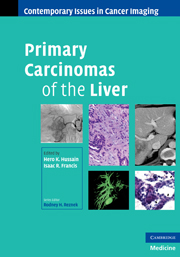Book contents
- Frontmatter
- Contents
- Contributors
- Series foreword
- Preface to Primary Carcinomas of the Liver
- 1 Epidemiology of hepatocellular carcinoma and cholangiocarcinoma
- 2 Surveillance and screening for hepatocellular carcinoma
- 3 Pathology of hepatocellular carcinoma, cholangiocarcinoma, and combined hepatocellular-cholangiocarcinoma
- 4 Radiological diagnosis of hepatocellular carcinoma
- 5 Staging of hepatocellular carcinoma
- 6 Surgical treatment of hepatocellular carcinoma: resection and transplantation
- 7 Non-surgical treatment of hepatocellular carcinoma
- 8 Radiological identification of residual and recurrent hepatocellular carcinoma
- 9 Radiological diagnosis of cholangiocarcinoma
- 10 Staging of cholangiocarcinoma
- 11 Treatment of cholangiocarcinoma
- 11.1 Surgical treatment: resection and transplantation
- 11.2 Non-surgical treatment
- 12 Uncommon hepatic tumors
- Index
- Color plates
- References
11.2 - Non-surgical treatment
from 11 - Treatment of cholangiocarcinoma
Published online by Cambridge University Press: 04 August 2010
- Frontmatter
- Contents
- Contributors
- Series foreword
- Preface to Primary Carcinomas of the Liver
- 1 Epidemiology of hepatocellular carcinoma and cholangiocarcinoma
- 2 Surveillance and screening for hepatocellular carcinoma
- 3 Pathology of hepatocellular carcinoma, cholangiocarcinoma, and combined hepatocellular-cholangiocarcinoma
- 4 Radiological diagnosis of hepatocellular carcinoma
- 5 Staging of hepatocellular carcinoma
- 6 Surgical treatment of hepatocellular carcinoma: resection and transplantation
- 7 Non-surgical treatment of hepatocellular carcinoma
- 8 Radiological identification of residual and recurrent hepatocellular carcinoma
- 9 Radiological diagnosis of cholangiocarcinoma
- 10 Staging of cholangiocarcinoma
- 11 Treatment of cholangiocarcinoma
- 11.1 Surgical treatment: resection and transplantation
- 11.2 Non-surgical treatment
- 12 Uncommon hepatic tumors
- Index
- Color plates
- References
Summary
This chapter outlines the available data on the role and use of radiotherapy (RT) in the treatment of biliary malignancies. Adjuvant, definitive, and palliative treatment are discussed for each different site along the biliary tract. The concepts, considerations, and techniques for upper abdominal RT are discussed in detail in Chapter 7.2a.
Postoperative radiotherapy
Surgery is the only potentially curative treatment for patients with biliary carcinoma. However, even with complete resection, the recurrence rate is high and long-term survival is poor. Local recurrence is a common pattern of failure and is associated with significant morbidity and mortality related to hepatobiliary complications. Adjuvant RT can potentially improve local control and survival, but data on its role in this setting are limited. Most of the data are derived from retrospective, single-institution experiences with possible selection bias favoring adjuvant treatments in well-performing patients or in patients with poor prognostic factors. Interpretation of these studies is further complicated by heterogeneity of disease stage, type of resection, and a variety of RT techniques and doses.
Intrahepatic cholangiocarcinoma
Most patients with intrahepatic cholangiocarcinoma (IHC) are not candidates for resection at presentation, mostly because of advanced disease within the liver. After resection, median and 5-year survival are 19 to 37.5 months and 13.6–40%, respectively. The majority of recurrences involve the liver, either alone or in combination with distant sites. Survival is directly related to the ability to obtain negative surgical margins and the absence of regional lymph-node involvement.
- Type
- Chapter
- Information
- Primary Carcinomas of the Liver , pp. 195 - 213Publisher: Cambridge University PressPrint publication year: 2009



